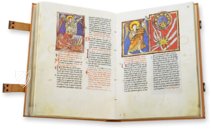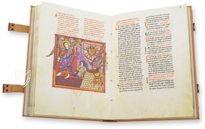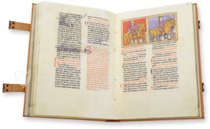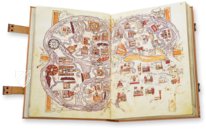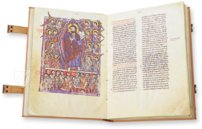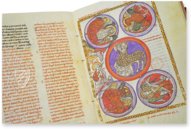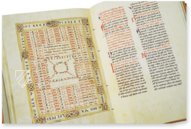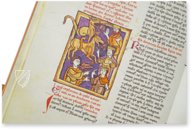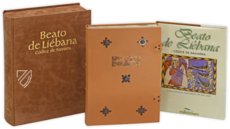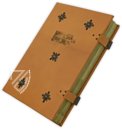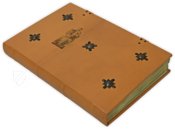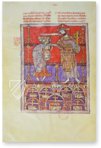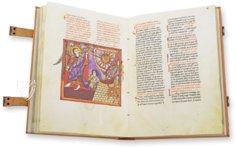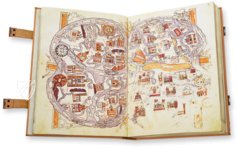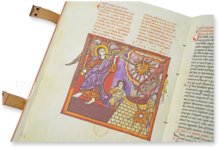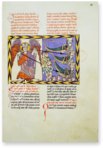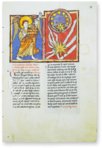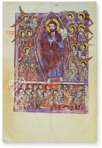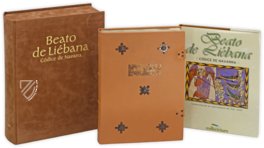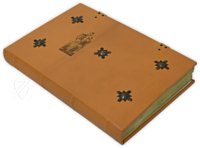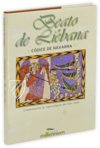Beatus of Liébana - Navarra Codex
(3,000€ - 7,000€)
The grandiose Navarra Beatus is an outstanding specimen of the North Spanish Beatus manuscripts of the 12th century. Impressive miniatures accompanying the famous 8th century Apocalypse commentary by Beatus of Liébana illustrate 64 of codex’s 314 pages. Multi-headed creatures, angels with trumpets, and other fantastic and sometimes terrifying figures and creatures populate this world. The Navarra Codex is completely bound up with the Spanish Beatus tradition. Alongside its particularly beautiful visual adornment, the history of the manuscript is one of the characteristics that makes it something special!
Beatus of Liébana - Navarra Codex
The grandiose Navarra Beatus is an outstanding specimen of the North Spanish Beatus manuscripts of the 12th century. Impressive miniatures accompanying the famous 8th century Apocalypse commentary by Beatus of Liébana illustrate 64 of codex’s 314 pages. Multi-headed creatures, angels with trumpets, and other fantastic and sometimes terrifying figures and creatures populate this world. The Navarra Codex is completely bound up with the Spanish Beatus tradition. Alongside its particularly beautiful visual adornment, the history of the manuscript is one of the characteristics that makes it something special!
The Famous Author of the Commentary
Beatus of Liébana (d. 798) was an important theologian and monk in the Asturian monastery of San Martín de Liébana. As an important scholar of his time, he is famous for his magnum opus, a commentary on the Apocalypse in twelve books, to this day. With its mysterious figures and terrifying events, the biblical Revelation of John about the end of the world offers many opportunities for interpretation, which require a thorough explanation. This was delivered by Beatus of Liébana in his clarifying and illuminating commentary. The Apocalypse commentary by Beatus attained great fame above all because of the numerous – mostly North Spanish – manuscripts, in which his text was recorded and illustrated from the 10th to the 13th century. These large-format and richly-illustrated codices constitute their own genre of illumination, the so-called Beatus Manuscripts.
Artistic Furnishings of the Highest Quality
The codex Ms. Nouv. Acq. Lat. 1366 of the Bibliothèque nationale de France in Paris is famous as the so-called Navarra Beatus. The gorgeous illuminations present themselves here full of luminosity and magic. Clearly, both the gorgeous Carolingian script with creatively-designed initials as well as the high-quality miniatures are stylistically Spanish, and the typical image program is closely associated with the Spanish Beatus tradition. The codex was made in the second half of the 12th century in Navarra, probably in Astorga in the La Rioja region, because this location is particularly explicitly referenced on the mappa mundi, the manuscript’s double-page world map.
Detailed and Mysterious Aspects of its History
The exact provenance of the Navarra Beatus remains a mystery to this day. According to the Jesuit priest José Moret, a magnificent Beatus codex existed in the library of the Navarra Cathedral in the 17th century. An additional exciting document from the year 1389 is imbedded in the binding of the codex, which King Charles III of Navarra (1361–1425) addressed to the Bishop of Dax, Juan Bauses, and the Prior of Roncesvalles, Miguel de Taver. Thus, conclusions can be made about the history of the manuscript. The Navarra Beatus passed through the hands of a book dealer on its way to Lyon, then Milan by means of another dealer, and finally came to Paris, where it was acquired by the Bibliothèque Nationale in 1879. The Navarra Beatus is a particularly beautiful example of this centuries-old Beatus tradition!
Codicology
- Alternative Titles
- Beatus von Liébana - Codex von Navarra
- Size / Format
- 314 pages / 34.5 × 23.5 cm
- Origin
- Spain
- Date
- 11th century
- Style
- Genre
- Language
- Illustrations
- 63 miniatures
- Artist / School
- Beatus of Liébana (died after 798) (author)
- Previous Owners
- Charles III of Navarra
Jean Bauses
Pamplona cathedral library
Beatus of Liébana - Navarra Codex
The Fifth Trumpet
Commanded by their king, the Angel Abbadon, an army of locust-hybrids launches an attack on mankind. “The shape of the locusts was like horses prepared for battle. On their heads were crowns of something like gold, and their faces were like the faces of men. They had hair like women’s hair, and their teeth were like lions’ teeth. And they had breastplates like breastplates of iron, and the sound of their wings was like the sound of chariots with many horses running into battle.” (Rev. 9:7-9)

Beatus of Liébana - Navarra Codex
John's Vision and Commission
“I was in the Spirit on the Lord’s Day, and I heard behind me a loud voice, as of a trumpet, saying, "I am the Alpha and the Omega, the First and the Last," and, "What you see, write in a book and send it to the seven churches which are in Asia: to Ephesus, to Smyrna, to Pergamos, to Thyatira, to Sardis, to Philadelphia, and to Laodicea.” (Rev. 1:10–11)
Christ appears before John with a sword in his mouth, standing among seven lampstands, representing the seven churches of Asia, and holding seven stars, representing the seven angels watching over these churches. Bowing before him, John accepts the commission in a scene that is typical of the Spanish Beatus tradition with rich shades of red and purple, which is then highlighted with gold leaf.
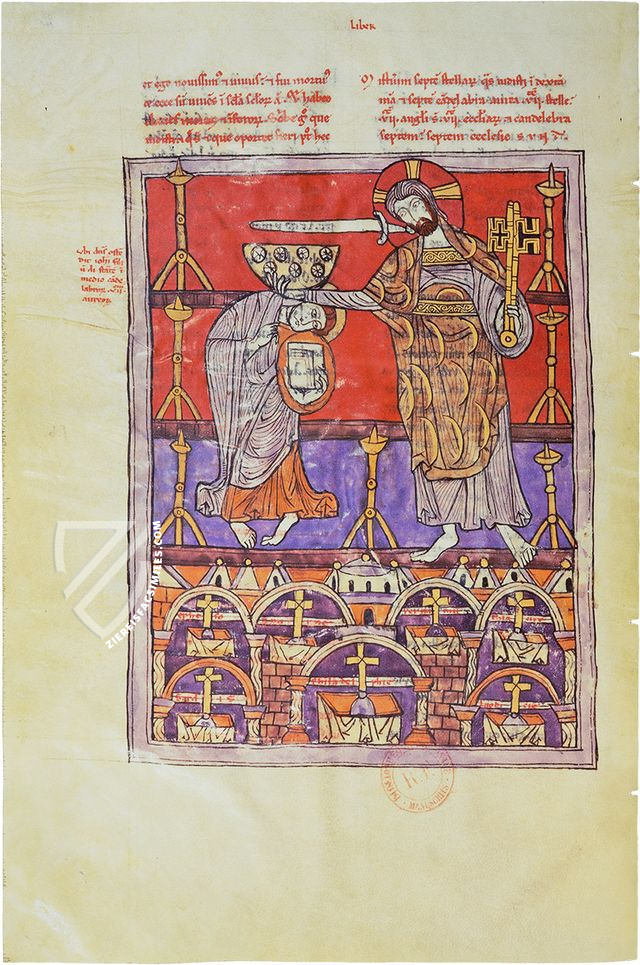
- Treatises / Secular Books
- Apocalypses / Beatus
- Astronomy / Astrology
- Bestiaries
- Bibles / Gospels
- Chronicles / History / Law
- Geography / Maps
- Saints' Lives
- Islam / Oriental
- Judaism / Hebrew
- Single Leaf Collections
- Leonardo da Vinci
- Literature / Poetry
- Liturgical Manuscripts
- Medicine / Botany / Alchemy
- Music
- Mythology / Prophecies
- Psalters
- Other Religious Books
- Games / Hunting
- Private Devotion Books
- Other Genres
- Afghanistan
- Armenia
- Austria
- Belgium
- Belize
- Bosnia and Herzegovina
- China
- Colombia
- Costa Rica
- Croatia
- Cyprus
- Czech Republic
- Denmark
- Egypt
- El Salvador
- Ethiopia
- France
- Germany
- Greece
- Guatemala
- Honduras
- Hungary
- India
- Iran
- Iraq
- Israel
- Italy
- Japan
- Jordan
- Kazakhstan
- Kyrgyzstan
- Lebanon
- Liechtenstein
- Luxembourg
- Mexico
- Morocco
- Netherlands
- Palestine
- Panama
- Peru
- Poland
- Portugal
- Romania
- Russia
- Serbia
- Spain
- Sri Lanka
- Sweden
- Switzerland
- Syria
- Tajikistan
- Turkey
- Turkmenistan
- Ukraine
- United Kingdom
- United States
- Uzbekistan
- Vatican City
- A. Oosthoek, van Holkema & Warendorf
- Aboca Museum
- Ajuntament de Valencia
- Akademie Verlag
- Akademische Druck- u. Verlagsanstalt (ADEVA)
- Aldo Ausilio Editore - Bottega d’Erasmo
- Alecto Historical Editions
- Alkuin Verlag
- Almqvist & Wiksell
- Amilcare Pizzi
- Andreas & Andreas Verlagsbuchhandlung
- Archa 90
- Archiv Verlag
- Archivi Edizioni
- Arnold Verlag
- ARS
- Ars Magna
- ArtCodex
- AyN Ediciones
- Azimuth Editions
- Badenia Verlag
- Bärenreiter-Verlag
- Belser Verlag
- Belser Verlag / WK Wertkontor
- Benziger Verlag
- Bernardinum Wydawnictwo
- BiblioGemma
- Biblioteca Apostolica Vaticana (Vaticanstadt, Vaticanstadt)
- Bibliotheca Palatina Faksimile Verlag
- Bibliotheca Rara
- Boydell & Brewer
- Bramante Edizioni
- Bredius Genootschap
- Brepols Publishers
- British Library
- C. Weckesser
- Caixa Catalunya
- Canesi
- CAPSA, Ars Scriptoria
- Caratzas Brothers, Publishers
- Carus Verlag
- Casamassima Libri
- Centrum Cartographie Verlag GmbH
- Chavane Verlag
- Christian Brandstätter Verlag
- Circulo Cientifico
- Club Bibliófilo Versol
- Club du Livre
- CM Editores
- Collegium Graphicum
- Collezione Apocrifa Da Vinci
- Comissão Nacional para as Comemorações dos Descobrimentos Portugueses
- Coron Verlag
- Corvina
- CTHS
- D. S. Brewer
- Damon
- De Agostini/UTET
- De Nederlandsche Boekhandel
- De Schutter
- Deuschle & Stemmle
- Deutscher Verlag für Kunstwissenschaft
- DIAMM
- Droz
- E. Schreiber Graphische Kunstanstalten
- Ediciones Boreal
- Ediciones Grial
- Ediclube
- Edições Inapa
- Edilan
- Editalia
- Edition Deuschle
- Edition Georg Popp
- Edition Leipzig
- Edition Libri Illustri
- Editiones Reales Sitios S. L.
- Éditions de l'Oiseau Lyre
- Editions Medicina Rara
- Editorial Casariego
- Editorial Mintzoa
- Editrice Antenore
- Editrice Velar
- Edizioni Edison
- Egeria, S.L.
- Eikon Editores
- Electa
- Emery Walker Limited
- Enciclopèdia Catalana
- Eos-Verlag
- Ephesus Publishing
- Ernst Battenberg
- Eugrammia Press
- Extraordinary Editions
- Fackelverlag
- Facsimila Art & Edition
- Facsimile Editions Ltd.
- Facsimilia Art & Edition Ebert KG
- Faksimile Verlag
- Feuermann Verlag
- Folger Shakespeare Library
- Franco Cosimo Panini Editore
- Friedrich Wittig Verlag
- Fundación Hullera Vasco-Leonesa
- G. Braziller
- Gabriele Mazzotta Editore
- Gebr. Mann Verlag
- Gesellschaft für graphische Industrie
- Getty Research Institute
- Giovanni Domenico de Rossi
- Giunti Editore
- Graffiti
- Grafica European Center of Fine Arts
- Guido Pressler
- Guillermo Blazquez
- Gustav Kiepenheuer
- H. N. Abrams
- Harrassowitz
- Harvard University Press
- Helikon
- Hendrickson Publishers
- Henning Oppermann
- Herder Verlag
- Hes & De Graaf Publishers
- Hoepli
- Holbein-Verlag
- Houghton Library
- Hugo Schmidt Verlag
- Idion Verlag
- Il Bulino, edizioni d'arte
- ILte
- Imago
- Insel Verlag
- Insel-Verlag Anton Kippenberger
- Instituto de Estudios Altoaragoneses
- Instituto Nacional de Antropología e Historia
- Istituto dell'Enciclopedia Italiana - Treccani
- Istituto Ellenico di Studi Bizantini e Postbizantini
- Istituto Geografico De Agostini
- Istituto Poligrafico e Zecca dello Stato
- Italarte Art Establishments
- Jan Thorbecke Verlag
- Johnson Reprint Corporation
- Josef Stocker
- Josef Stocker-Schmid
- Jugoslavija
- Karl W. Hiersemann
- Kasper Straube
- Kaydeda Ediciones
- Kindler Verlag / Coron Verlag
- Kodansha International Ltd.
- Konrad Kölbl Verlag
- Kurt Wolff Verlag
- La Liberia dello Stato
- La Linea Editrice
- La Meta Editore
- Lambert Schneider
- Landeskreditbank Baden-Württemberg
- Leo S. Olschki
- Les Incunables
- Liber Artis
- Library of Congress
- Libreria Musicale Italiana
- Lichtdruck
- Lito Immagine Editore
- Lumen Artis
- Lund Humphries
- M. Moleiro Editor
- Maison des Sciences de l'homme et de la société de Poitiers
- Manuscriptum
- Martinus Nijhoff
- Maruzen-Yushodo Co. Ltd.
- MASA
- Massada Publishers
- McGraw-Hill
- Metropolitan Museum of Art
- Militos
- Millennium Liber
- Müller & Schindler
- Nahar - Stavit
- Nahar and Steimatzky
- National Library of Wales
- Neri Pozza
- Nova Charta
- Oceanum Verlag
- Odeon
- Orbis Mediaevalis
- Orbis Pictus
- Österreichische Staatsdruckerei
- Oxford University Press
- Pageant Books
- Parzellers Buchverlag
- Patrimonio Ediciones
- Pattloch Verlag
- PIAF
- Pieper Verlag
- Plon-Nourrit et cie
- Poligrafiche Bolis
- Presses Universitaires de Strasbourg
- Prestel Verlag
- Princeton University Press
- Prisma Verlag
- Priuli & Verlucca, editori
- Pro Sport Verlag
- Propyläen Verlag
- Pytheas Books
- Quaternio Verlag Luzern
- Reales Sitios
- Recht-Verlag
- Reichert Verlag
- Reichsdruckerei
- Reprint Verlag
- Riehn & Reusch
- Roberto Vattori Editore
- Rosenkilde and Bagger
- Roxburghe Club
- Salerno Editrice
- Saltellus Press
- Sandoz
- Sarajevo Svjetlost
- Schöck ArtPrint Kft.
- Schulsinger Brothers
- Scolar Press
- Scrinium
- Scripta Maneant
- Scriptorium
- Shazar
- Siloé, arte y bibliofilia
- SISMEL - Edizioni del Galluzzo
- Sociedad Mexicana de Antropología
- Société des Bibliophiles & Iconophiles de Belgique
- Soncin Publishing
- Sorli Ediciones
- Stainer and Bell
- Studer
- Styria Verlag
- Sumptibus Pragopress
- Szegedi Tudomànyegyetem
- Taberna Libraria
- Tarshish Books
- Taschen
- Tempus Libri
- Testimonio Compañía Editorial
- Thames and Hudson
- The Clear Vue Publishing Partnership Limited
- The Facsimile Codex
- The Folio Society
- The Marquess of Normanby
- The Richard III and Yorkist History Trust
- Tip.Le.Co
- TouchArt
- TREC Publishing House
- TRI Publishing Co.
- Trident Editore
- Tuliba Collection
- Typis Regiae Officinae Polygraphicae
- Union Verlag Berlin
- Universidad de Granada
- University of California Press
- University of Chicago Press
- Urs Graf
- Vallecchi
- Van Wijnen
- VCH, Acta Humaniora
- VDI Verlag
- VEB Deutscher Verlag für Musik
- Verlag Anton Pustet / Andreas Verlag
- Verlag Bibliophile Drucke Josef Stocker
- Verlag der Münchner Drucke
- Verlag für Regionalgeschichte
- Verlag Styria
- Vicent Garcia Editores
- W. Turnowski Ltd.
- W. Turnowsky
- Waanders Printers
- Wiener Mechitharisten-Congregation (Wien, Österreich)
- Wissenschaftliche Buchgesellschaft
- Wissenschaftliche Verlagsgesellschaft
- Wydawnictwo Dolnoslaskie
- Xuntanza Editorial
- Zakład Narodowy
- Zollikofer AG








